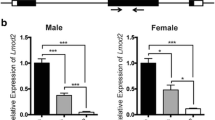Abstract
Genetic defects of the dystrophin-glycoprotein complex (DGC) cause hereditary dilated cardiomyopathy. Enteroviruses can also cause cardiomyopathy and we have previously described a mechanism involved in enterovirus-induced dilated cardiomyopathy: The enteroviral protease 2A directly cleaves dystrophin in the hinge 3 region, leading to functional dystrophin impairment. During infection of mice with coxsackievirus B3, the DGC in the heart is disrupted and the sarcolemmal integrity is lost in virus-infected cardiomyocytes. Additionally, dystrophin deficiency markedly increases enterovirus-induced cardiomyopathy in vivo, suggesting a pathogenetic role of the dystrophin cleavage in enterovirus-induced cardiomyopathy. Here, we extend these experimental findings to a patient with dilated cardiomyopathy due to a coxsackievirus B2 myocarditis. Endomyocardial biopsy specimens showed an inflammatory infiltrate and myocytolysis. Immunostaining for the enteroviral capsid antigen VP1 revealed virus-infected cardiomyocytes. Focal areas of cardiomyocytes displayed a loss of the sarcolemmal staining pattern for dystrophin and β-sarcoglycan identical to previous findings in virus-infected mouse hearts. In vitro, coxsackievirus B2 protease 2A cleaved human dystrophin. These findings demonstrate that in human coxsackievirus B myocarditis a focal disruption of the DGC can principally occur and may contribute to the pathogenesis of human enterovirus-induced dilated cardiomyopathy.



Similar content being viewed by others
References
Baboonian C, Davies MJ, Booth JC, McKenna WJ (1997) Coxsackie B viruses and human heart disease. Curr Top Microbiol Immunol 223:31–52
Badorff C, Lee GH, Lamphear BJ, Martone ME, Campbell KP, Rhoads RE, Knowlton KU (1999) Enteroviral protease 2A cleaves dystrophin: evidence of cytoskeletal disruption in an acquired cardiomyopathy. Nat Med 5:320–326
Badorff C, Berkley N, Mehrotra S, Talhouk JW, Rhoads RE, Knowlton KU (2000) Enteroviral protease 2A directly cleaves dystrophin and is inhibited by a dystrophin-based substrate analogue. J Biol Chem 275:1191–1197
Badorff C, Fichtlscherer B, Rhoads RE, Zeiher AM, Mülsch A, Dimmeler S, Knowlton KU (2000) Nitric oxide inhibits dystrophin cleavage by Coxsackieviral protease 2A through S-nitrosylation: a protective mechanism against enteroviral cardiomyopathy. Circulation 102:2276–2281
Badorff C, Mülsch A, Zeiher AM, Dimmeler S (2002) Selective delivery of nitric oxide to a cellular target: a pseudosubstrate-coupled dinitrosyl iron complex inhibits the enteroviral protease 2A. Nitric Oxide 6:305–312
Barresi R, Di Blasi C, Negri T, Brugnoni R, Vitali A, Felisari G, Salandi A, Daniel S, Cornelio F, Morandi L, Mora M (2000) Disruption of heart sarcoglycan complex and severe cardiomyopathy caused by beta sarcoglycan mutations. J Med Genet 37:102–107
Beggs AH (1997) Dystrophinopathy, the expanding phenotype. Dystrophin abnormalities in X-linked dilated cardiomyopathy. Circulation 95:2344–2347
Blom N, Hansen J, Blaas D, Brunak S (1996) Cleavage site analysis in picornaviral polyproteins: discovering cellular targets by neural networks. Protein Sci 5:2203–2216
Chen J, Chien KR (1999) Complexity in simplicity: monogenic disorders and complex cardiomyopathies. J Clin Invest 103:1483–1485
Fadic R, Sunada Y, Waclawik AJ, Buck S, Lewandoski PJ, Campbell KP, Lotz BP (1996) Brief report: deficiency of a dystrophin-associated glycoprotein adhalin in a patient with muscular dystrophy and cardiomyopathy. N Engl J Med 334:362–366
Graham RM, Owens WA (1999) Pathogenesis of inherited forms of dilated cardiomyopathy. N Engl J Med 341:1759–1762
Knowlton KU, Badorff C (1999) The immune system in viral myocarditis: maintaining the balance. Circ Res 85:559–561
Lee GH, Badorff C, Knowlton KU (2000) Dissociation of sarcoglycans and the dystrophin carboxl terminus from the sarcolemma in enteroviral cardiomyopathy. Circ Res 876:489–495
Li Y, Bourlet T, Andreoletti L, Mosnier JF, Peng T, Yang Y, Archard LC, Pozzetto B, Zhang H (2000) Enteroviral capsid protein VP1 is present in myocardial tissues from some patients with myocarditis or dilated cardiomyopathy. Circulation 101:231–234
Martino TA, Liu P, Sole MJ (1994) Viral infection and the pathogenesis of dilated cardiomyopathy. Circ Res 74:182–188
Melacini P, Fanin M, Danieli GA, Villanova C, Martinello F, Miorin M, Freda MP, Miorelli M, Mostacciuolo ML, Fasoli G, Angelini C, Dalla Volta S (1996) Myocardial involvement is very frequent among patients affected with subclinical Becker's muscular dystrophy. Circulation 94:3168–3175
Oldstone MBA (1998) Viruses, plaques and history. Oxford University Press, New York
Towbin JA (1998) The role of cytoskeletal proteins in cardiomyopathies. Curr Opin Cell Biol 10:131–139
Wessely R, Henke A, Zell R, Kandolf R, Knowlton KU (1998) Low level expression of a mutant coxsackieviral cDNA induces a myocytopathic effect in culture: an approach to the study of enteroviral persistence in cardiac myocytes. Circulation 98: 450–457
Wessely R, Klingel K, Santana LF, Dalton N, Hongo M, Lederer JW, Kandolf R, Knowlton KU (1998) Transgenic expression of replication-restricted enteroviral genomes in heart muscle induces defective excitation-contraction coupling and dilated cardiomyopathy. J Clin Invest 102:1444–1453
Xiong D, Lee GH, Badorff C, Lee S, Wolf P, Knowlton KU (2002) Dystrophin deficiency markedly increases enterovirus-induced cardiomyopathy: a genetic predisposition to viral heart disease. Nat Med 8:872–877
Acknowledgements
This work was supported by grants from the Deutsche Forschungsgemeinschaft (Ba1668/3-1) to C.B., NIH RO1 HL57365-01 and an AHA Established Investigator Award to K.U.K. We appreciate the assistance of Denise Herman and Neil Sawhney (Department of Medicine, University of California, San Diego) who made available the myocardial biopsy material on the patient with myocarditis, Roland Zell (Department of Virology, Schiller-University, Jena, Germany) for performing PCR of the coxsackievirus B2 protease 2A, and David Rapaport (Department of Surgery, University of California, San Diego) for help with the immunofluorescence.
Author information
Authors and Affiliations
Corresponding author
Rights and permissions
About this article
Cite this article
Badorff, C., Knowlton, K.U. Dystrophin disruption in enterovirus-induced myocarditis and dilated cardiomyopathy: from bench to bedside. Med Microbiol Immunol 193, 121–126 (2004). https://doi.org/10.1007/s00430-003-0189-7
Received:
Published:
Issue Date:
DOI: https://doi.org/10.1007/s00430-003-0189-7




